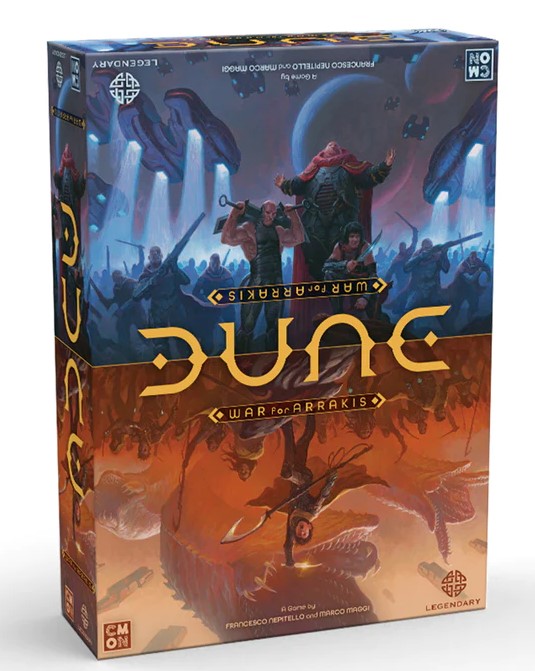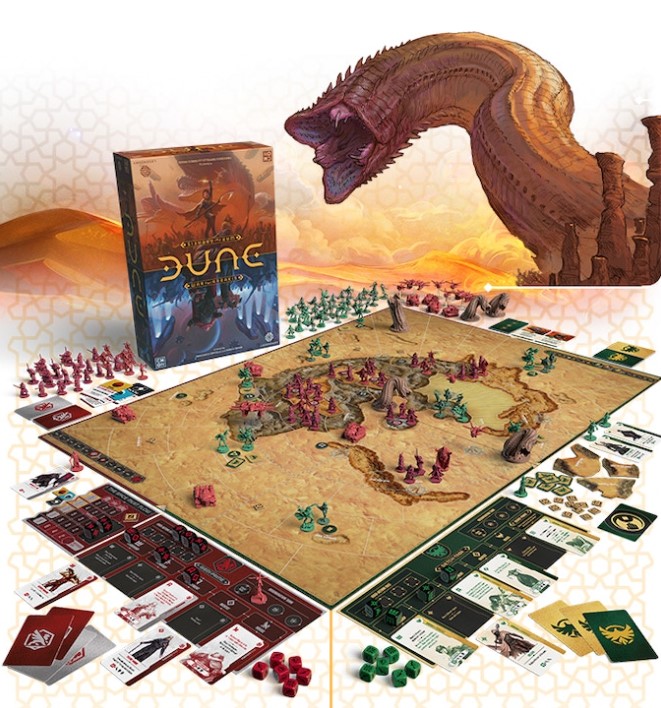It’s a great time to be a board gamer, full stop. Every year, thousands of new titles are published, classics are brought back into print, and methods like crowdfunding and print-and-play let designers bring fresh ideas to life. That said, with so much to play, sifting through all the options to find what fits you and your group’s style can be hard. Enter, the Best Board Games of 2024: Q1, which plays host to some of the more notable titles, and recommendations worth your gaming time, across a range of genres, to help fill out your collection.
So, without further ado, here are some of the Best Board Games of 2024: Q1
A Pleasant Nature Puzzle
Enjoying beautiful art while building a nature preserve has become one of board gaming’s recurrent themes across the last few years. Cascadia, Meadow, Wingspan, and plenty more have embraced the idea that board gaming can be an opportunity to relax and score some points. That trend continues with Harmonies (Johan Benvenuto), which combines pattern-matching, tile placement, and light drafting into a sub 60 minute delight.
Sitting down with Harmonies sees every player reaching into a central bag, drawing out wooden tokens with habitats on them (you know the symbols: leaves, rivers, rocks, etc.) and placing them on your personal board. You’ll be dropping those tokens to match patterns on drafted animal cards—the frog must have water and plant tiles next to each other, for example—to score additional points. Some critters want their territory stacked too, adding a vertical puzzle element that puts just enough oomph into Harmonies to keep it interesting. Sure, you won’t be invading each other’s territory, and while I suppose a particularly vicious group could see counter-drafting, the fact that you’d be hindering yourself so much by picking animals to stop opponents means, well, if that’s the vibe you’re going for, I’d pick a different game.
element that puts just enough oomph into Harmonies to keep it interesting. Sure, you won’t be invading each other’s territory, and while I suppose a particularly vicious group could see counter-drafting, the fact that you’d be hindering yourself so much by picking animals to stop opponents means, well, if that’s the vibe you’re going for, I’d pick a different game.
Position your patterns well to grow your habitat and make a home for your critter collective to scoop up sweet, sweet points, and have a neat, 3D board at the end. Satisfying?
You betcha.
Harmonies presents itself as a beautiful showpiece to hold down a weeknight gaming session with up to four players. Sip some wine, place some tiles, and make plans to go for a hike to see the excellent card art in real life. If you’ve yet to dip into the cozy nature board gaming trend, Harmonies is a great place to start.
Going Beneath the Ice in Warhammer Underworlds
If discordant melodies made by, say, the clash of blade on blade are more your style, then Warhammer Underworlds is set to give you your fix. This relatively long-running skirmish game gets annual (and often more frequent) releases, and slims itself down to a tight head-to-head duel from its bigger brothers. Rather than sculpting tables-worth of terrain and gathering a codex library, Warhammer Underworlds delivers a deck-building duel close to the likes of Summoner Wars and Mythic Battles. You’ll still get the immaculate miniatures, the smaller count meaning you might actually have a chance to paint them, and given its fantasy setting, they’ll be deploying teeth, claws, and, well, warhammers real nice and close.
Warhammer Underworlds delivers turn-by-turn action through a hand drawn from your deck, one likely to begin with a pre-made collection culled from your starter set of choice—2024’s Wintermaw, for example, sees you hunting souls in harrowing ice caves. Every turn will see you taking a few actions driven by the cards in your hand, but which ought to be in service of your objectives. Are you attempting to capture and hold a point on the map? Slaughter the opposition? Steal an artifact? Those goals give Underworlds fresh variance amid the crowded skirmish landscape, as both players have their own, separate decks of objective cards. That’s right – you might be tasked with holding a spot on the map while your opponent scores plenty of points by snagging the magical macguffin in the middle.
Can you simultaneously, with only a few figures, both stop them and hold your territory?
That’s a much more interesting quandary than who can roll the best dice in a mosh pit battle. To make things even more interesting, those objective cards score in different rounds, shifting as the match plays and forcing you to keep moving, reacting, ambushing. Simply sitting in the corner and counting your points won’t get you the win.
Helping you complete those objectives will be your units (making up your warband) and your power deck. Units get to activate, running around attacking and slinging special abilities, hoping to decimate your enemies or salve your allies. Then you’ll use cards drawn from a power deck, one you can customize (like the objective deck) as you get more familiar with the game. These cards might be powerful spells, tricks, or game-changing effects. Fast, furious, and constantly moving, Warhammer Underworlds is a game to play when you want to go.
It’s also an easy one for tournaments or weeknight back-and-forth bouts, with matches taking well under an hour once you know the rules. There’s only a few rounds per game, keeping things tight and preventing the sort of drawn out dice-tossing slogs that devour whole afternoons. With plenty of expansions and opportunities for custom deck-building, warband assembly, and battlefields, Warhammer Underworlds is a tactical skirmish system worth diving into, and 2024’s Wintermaw is a perfect place to start.
An Epic Dune Wargame
Everywhere you look these days, Frank Herbert’s sandy universe is there. Dune games are all over the place, covering genres from multiplayer chaos simulator in Dune (by Galeforce Nine, but yes, it’s just called Dune, which doesn’t make my job any easier), to worker placement with Dune: Imperium and its cottage industry of expansions and sequels, to adventure gaming with Dune: House Secrets. Here, though, we’re venturing into yet another genre with Dune: War for Arrakis (Marco Maggi, Francesco Nepitello), a heavy, primarily two-player, war game along the lines of War of the Ring and Star Wars: Rebellion.
Those last two titles might draw some curiosity, because both War of the Ring and Star Wars: Rebellion are justifiably renowned for capturing the theme and feel of their settings. You’ll feel like Sauron sending your orcs out to squash the pitiful humans, and you’ll sneak around as the Rebellion, trying to keep your tiny fleet out of the Empire’s hands. Dune: War for Arrakis achieves this same aura by pitting House Harkonnen against House Atreides on the desert planet, with Harkonnen the hammering military force and Atreides the clever, sandworm-riding tricksters.
The first indication this isn’t a simple licensed affair comes when you open up the detailed map and lay out the asymmetric decks, units, and dice. You’ll be spending a couple hours butting heads in the desert, so the component quality is important. CMON is a well-established publisher, and while you’ll find plenty of minis in the box, everything packs a level of polish you won’t find in typical cash-ins.
plenty of minis in the box, everything packs a level of polish you won’t find in typical cash-ins.
After you’ve shuffled each side’s unique event deck, it’s time to roll some action dice. Just like War of the Ring, what you roll will drive what you’re able to do on your turn. You might use one of those dice to play a special event from your hand, dropping warriors into the desert planet, or spend another to harvest spice to score some early points. As victory goes to the first side who reaches 10 on the ‘Supremacy Track’, snagging a couple from spice can be a big part of victory. Points can otherwise come from classic war game sources: conquering territory, destroying the enemy, surreptitiously moving your counter up a notch and hoping your opponent doesn’t notice . . . you know, the usual.
Combat is quick and brutal: a single, unmodified dice roll with minimal misses and maximum casualties. You won’t burn rounds in tedious sieges, dig through tables, or alternate smacking each other around with special card effects. You’ll chuck those cubes, wince or crow at the results, and get on with the sandy slaughter.
Which is what makes Dune: War for Arrakis such a winner, one that slots in just fine with its hallowed brethren. This game is streamlined, fast (relatively – a couple of hours rather than a whole evening), and focused on fun over rules-heavy ‘realism’. You won’t get the extensive edge cases that stuff War of the Ring nor card-heavy combat rounds of Star Wars: Rebellion, and that makes Dune: War for Arrakis a far easier teach, and therefore, a far easier game to table.
For folks who can’t have enough Dune, there’s also a Spacing Guild expansion and other associated goodies out and about to deluxify your game, but don’t let those bits and bobs keep you away from a fantastically fun time slugging it out over spice. This one’s a thematic wargaming winner, and worth adding to your collection.
It’s a Great Time to be a Board Gamer
With so many new board games coming out every year, it’s a player’s paradise. The three above are some fun highlights of this year’s first few months, experiences ranging from epic planetary conflict to a pleasant pattern puzzle starring your favorite woodland critters. As we return to this series every quarter, we’ll highlight different types of titles, so if you love trick-taking or a meaty hex-and-counter clash, fear not, we’ll showcase some neat offerings in those genres soon.
quarter, we’ll highlight different types of titles, so if you love trick-taking or a meaty hex-and-counter clash, fear not, we’ll showcase some neat offerings in those genres soon.
And in between matches, you could do worse than reading Dune again: it seems the spice can, and will, flow until it takes over all the games, everywhere. Be ready.
